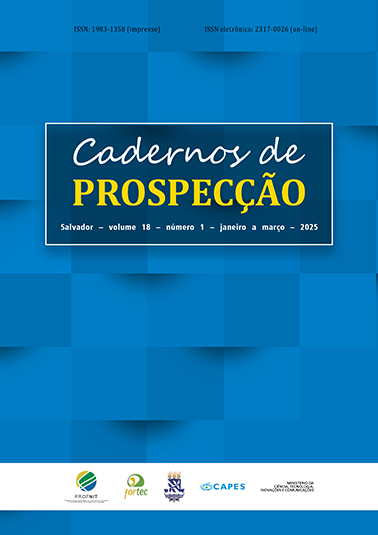Geothermy for Cooling Purposes: a patent prospect
DOI:
https://doi.org/10.9771/cp.v18i1.60399Keywords:
Thermal comfort, Patents, Underground tubes.Abstract
This article deals with a patent prospecting on the subject of geothermal energy, which proposes to use the soil as a way of exchanging heat with the air. As a result of its high thermal capacity, the soil can act as a thermal reservoir, heating or cooling the air inside buildings, depending on the climate conditions. Thus, the objective is to map technologies related to geothermal energy applied to cooling. A patent review was used, through the Questel Orbit® platform, and 226 patents were identified. The results show that among the largest assignees is Tokai Kogyo, a Japanese factory based in Õnu, which stands out from the other assignees, having fifteen families of patents; the technologies are related to machines and equipment in the air conditioning sector. The research recognizes the economic and environmental benefits of geothermal energy compared to traditional solutions, although only a single study was located for tropical climates.
Downloads
References
AGRAWAL, K. K. et al. The state of art on the applications, technology integration, and latest research trends of earth-air-heat exchanger system. Geothermics, [s.l.], v. 82, p. 34-50, 2019.
BARCELOS, R. H. Viabilidade técnica e econômica do condicionamento geotérmico de edificações no Rio Grande do Sul. 2018. 161p. Dissertação (Mestrado) – Universidade Federal do Rio Grande do Sul, Porto Alegre, 2018.
BITENCOURT, D. P. et al. Frequência, Duração, Abrangência Espacial e Intensidade das Ondas de Calor no Brasil. Revista Brasileira de Meteorologia, São Paulo, v. 31, n. 4, p. 506-517, 2016.
EPE – EMPRESA DE PESQUISA ENERGÉTICA. Plano Decanal de Energia – 2050. 2024. Disponível em: https://www.epe.gov.br/pt/publicacoes-dados-abertos/publicacoes/Plano-Nacional-de-Energia-2050. Acesso em: 20 ago. 2024.
HAZER, H. The use of Earth Covered Buildings. In: PROCEEDINGS OF CONFERENCE ON ALTERNATIVES IN ENERGY CONSERVATION: THE USE OF EARTH-COVERED BUILDINGS. 1975, Texas: US GPO. p. 21-36. Anais […]. Texas, 1975.
HOLLMULLER, P. et al. Potential of buried pipes systems and derived techniques for passive cooling of buildings in Brazilian climates. AIVC. 2006. Disponível em: http://www.labeee.ufsc.br/sites/f. Santa Catarina, 2006. Acesso em: 11 maio 2023.
INMET – INSTITUTO NACIONAL DE METEOROLOGIA. Portal Inmet. 2023. Disponível em: https://portal.inmet.gov.br/noticias/ondas-de-calor-s%C3%A3o-resultados-das-altera%C3%A7%C3%B5es-clim%C3%A1ticas-nos-%C3%BAltimos-60-anos. Acesso em: 15 mar 2024.
IPCC – INTERGOVERNMENTAL PANEL ON CLIMATE CHANCE. Climate Change 2022: Synthesis Report. Contribution of Working Groups I, II and III to the Fourth Assessment Report of the Intergovernmental Panel on Climate Change. Geneva, Switzerland, 2022.
ÔMIDO, A. R.; AGOSTINHO, V. P. Análise da geotermia superficial de Ouro Verde – SP para climatização do ambiente construído mediante o potencial energético do solo local. In: XI CONGRESSO BRASILEIRO DE GESTÃO AMBIENTAL. Vitória, ES, 2020. Anais […]. Vitória, ES, 2020.
OMIDO, A. R.; BARBOZA, C. S.; AGOSTINHO, V. P. Monitoramento da temperatura do subsolo de Ouro Verde – SP para embasar a utilização da energia geotérmica superficial na climatização do ambiente construído. In: XII CONGRESSO BRASILEIRO DE GESTÃO AMBIENTAL. Salvador, BA, 2021. Anais […]. Salvador, BA, 2021.
OZGENER, L. A review on the experimental and analytical analysis of earth to air heat exchanger (EAHE) systems in Turkey. Renewable and Sustainable Energy Reviews, [s.l.], v. 15, p. 9, 2011.
PORTO, A. H. H. et al. Geotermia aplicada às edificações e relações com a cobertura do solo e consumo de energia. In: CARAGNANI, G.; DURANTE, L. C.; SANCHES, J. C. M. (org.). Habitação de Interesse Social em Mato Grosso: Contribuições Científicas. Cáceres, MT: Editora Unemat, 2018.
QUESTEL ORBIT. Página de busca. 2023. Disponível em: https://www.orbit.com/#PatentRegularAdvancedSearchPage. Acesso em: 10 jul. 2023.
SANCHES, Í. S. et al. A prelude to the utilization of surface geothermal energy in the climatization of the constructed environment in the City of Naviraí, Mato Grosso do Sul State, Brazil. Research, Society and Development, [s.l.], v. 9, n. 10, e4909108864, 2020.
SANTANA, B. G.; RIBEIRO, M. E. Implementação de permutador de calor solo-ar (EAHE) para melhorar o conforto térmico de edificações. 2019. 75p. Trabalho de Conclusão de Curso (Graduação) – Universidade de Brasília, Brasília, DF, 2019.
Downloads
Published
How to Cite
Issue
Section
License
Copyright (c) 2024 Cadernos de Prospecção

This work is licensed under a Creative Commons Attribution-NonCommercial 4.0 International License.
O autor declara que: - Todos os autores foram nomeados. - Está submetendo o manuscrito com o consentimento dos outros autores. - Caso o trabalho submetido tiver sido contratado por algum empregador, tem o consentimento do referido empregador. - Os autores estão cientes de que é condição de publicação que os manuscritos submetidos a esta revista não tenham sido publicados anteriormente e não sejam submetidos ou publicados simultaneamente em outro periódico sem prévia autorização do Conselho Editorial. - Os autores concordam que o seu artigo ou parte dele possa ser distribuído e/ou reproduzido por qualquer forma, incluindo traduções, desde que sejam citados de modo completo esta revista e os autores do manuscrito. - Revista Cadernos de Prospecção está licenciado com uma Licença Creative Commons Attribution 4.0. Esta licença permite que outros remixem, adaptem e criem a partir do seu trabalho para fins não comerciais, e embora os novos trabalhos tenham de lhe atribuir o devido crédito e não possam ser usados para fins comerciais, os usuários não têm de licenciar esses trabalhos derivados sob os mesmos termos.
Este obra está licenciado com uma Licença Creative Commons Atribuição 4.0 Internacional.








